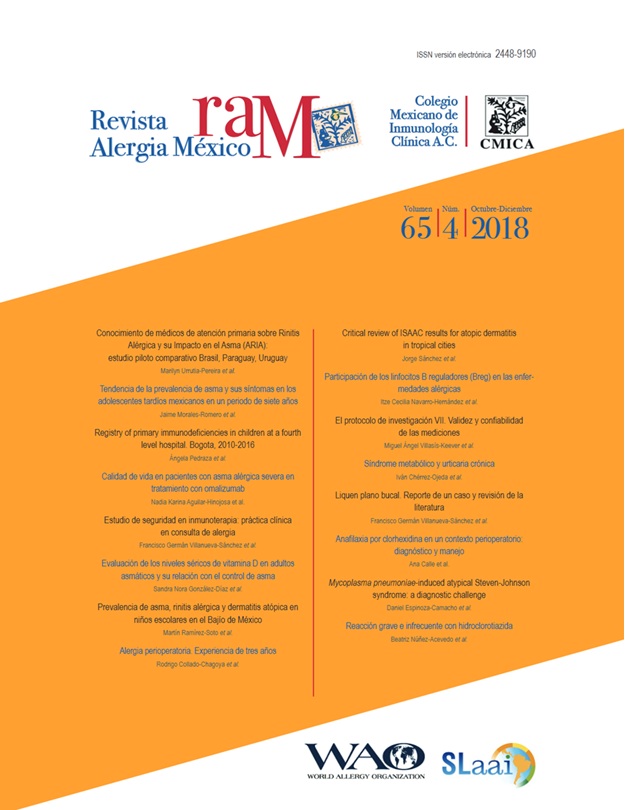Abstract
Background: Perioperative hypersensitivity reactions constitute a global health problem, with an estimated incidence of 1 per 100,000 procedures and a mortality rate of 0.1 to 9 %. Main risk factors are a history of allergy to other drugs, atopy, associated psychiatric disorders and previous surgeries.
Objectives: To determine the frequency of sensitization and the type of drugs involved in perioperative allergy in a tertiary care hospital, over a 3-year period.
Methods: Retrospective, cross-sectional, descriptive study of perioperative allergy, corroborated by skin tests for each drug and latex, of patients treated at the Allergy and Clinical Immunology Department of Hospital General de Mexico.
Results: Twenty-eight patients diagnosed with perioperative allergy were included. Main triggers were neuromuscular blocking agents (46.42 %), latex (28.52 %) and propofol (14.28 %). The main risk factor was a history of previous surgeries (89.28 %). Most perioperative allergic reactions were mild (71.42 %) and occurred within the postoperative period (60.71 %).
Conclusions: Initial diagnosis and Treatment should always be carried out by the anesthesiologist or surgeon, who should focus on the withdrawal of possible causative agents.
References
Laxenaire MC, Mertes PM, Benabes B. Anaphylaxis during anaesthesia: results from a two-year survey in France. Br J Anaesth. 2001;87(4):549-558. DOI: 10.1093/bja/87.4.549
Krøigaard M, Garvey LH, Menné T, Husum B. Allergic reactions in anaesthesia: are suspected causes confirmed on subsequent testing? Br J Anaesth. 2005;95(4):468-471. DOI: 10.1093/bja/aei198
Volcheck GW, Mertes PM. Local and general anesthetics immediate hypersensitivity reactions. Immunol Allergy Clin North Am. 2014;34(3):525-546. DOI: 10.1016/j.iac.2014.03.004
Lobera T, Audicana MT, Pozo MD, Blasco A, Fernández E, Canada P, et al. Study of hypersensitivity reactions and anaphylaxis during anesthesia in Spain. J Investig Allergol Clin Immunol. 2008;18(5):350-356.
Berroa F, Lafuente A, Javaloyes G, Cabrera-Freitag P, de la Borbolla JM, Moncada R et al. The incidence of perioperative hypersensitivity reactions: a single-center, prospective, cohort study. Anesth Analg. 2015;121(1):117-123. DOI: 10.1213/ANE.0000000000000776
Edwards IR, Aronson JK. Adverse drug reactions: definitions, diagnosis, and management. Lancet. 2000;356(9237):1255-1259. DOI: 10.1016/S0140-6736(00)02799-9
Muñoz-Cano R, Picado C, Valero A, Bartra J. Mechanisms of anaphylaxis beyond IgE. J Investig Allergol Clin Immunol. 2016;26(2):73-82. DOI: 10.18176/jiaci.0046
Peavy RD, Metcalfe DD. Understanding mechanisms of anaphylaxis. Curr Opin Allergy Clin Immunol. 2008;8(4):310-315. DOI: 10.1097/ACI.0b013e3283036a90
Golden D, Wallace DV, Bernstein J, Dinakar C, Greenhawt M, Khan DA, et al. The diagnosis and management of anaphylaxis: an updated practice parameter. J Allergy Clin Immunol. 2005;115(3 Suppl 2):S483-S523. DOI: 10.1016/j.jaci.2005.01.010
Levy JH, Yegin A. Anaphylaxis: what is monitored to make a diagnosis? How is therapy monitored? Anesthesiol Clin North Am. 2001;19(4):705-715. DOI: 10.1016/S0889-8537(01)80008-0
Ebo DG, Fisher MM, Hagendorens MM, Bridts CH, Stevens WJ. Anaphylaxis during anaesthesia: diagnostic approach. Allergy. 2007;62(5):471-487. DOI: 10.1111/j.1398-9995.2007.01347.x
Brockow K, Garvey LH, Aberer W, Atanaskovic-Markovic M, Barbaud A, Bilo MB, et al. Skin test concentrations for systemically administered drugs: an ENDA/EAACI Drug Allergy Interest Group position paper. Allergy. 2013;68(6):702-712. DOI: 10.1111/all.12142
Aberer W, Bircher A, Romano A, Blanca M, Campi P, Fernández J, et al. Drug provocation testing in the diagnosis of drug hypersensitivity reactions: general considerations. Allergy. 2003;58(9):854-863. DOI: 10.1034/j.1398-9995.2003.00279.x
Brown SG, Mullins RJ, Gold MS. Anaphylaxis: diagnosis and management. Med J Aust. 2006;185(5):283-289.
Simons FER, Ardusso LRF, Bilò MB, Dimov V, Ebisawa M, El-Gamal YM, et al. World Allergy Organization guidelines for the assessment and management of anaphylaxis. World Allergy Organ J. 2011;4(2):13-37. DOI: 0.1097/WOX.0b013e318211496c
Simons FE, Ardusso LR, Bilò MB, Cardona V, Ebisawa M, El-Gamal YM, et al. International consensus on (ICON) anaphylaxis. World Allergy Organ J. 2014;7(1):9. DOI: 10.1186/1939-4551-7-9
Campbell RL, Li JTC, Nicklas RA, Sadosty AT, Bernstein D, Blessing-Moore J, et al. Emergency department diagnosis and treatment of anaphylaxis: a practice parameter. Ann Allergy Asthma Immunol. 2014;113:599-608. DOI: 10.1016/j.anai.2014.10.007
Mirakian R, Ewan PW, Durham SR, Youlten LJ, Dugué P, Friedmann PS, et al. BSACI guidelines for the management of drug allergy. Clin Exp Allergy. 2009;39(1):43-61. DOI: 10.1111/j.1365-2222.2008.03155.x
Muraro A, Roberts G, Worm M, Bilò MB, Brockow K, Fernández Rivas M, et al. Anaphylaxis: guidelines from the European Academy of Allergy and Clinical Immunology. Allergy. 2014;69(8):1026-1045. DOI: 10.1111/all.12437

This work is licensed under a Creative Commons Attribution-NonCommercial 4.0 International License.
Copyright (c) 2018 Revista Alergia México

